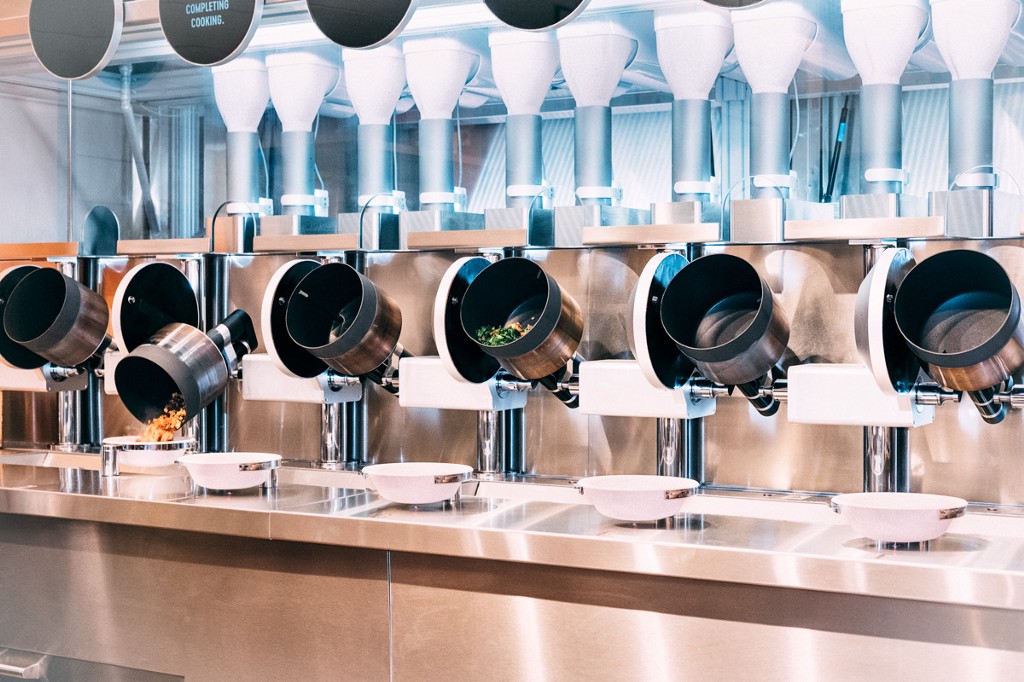The idea of a restaurant where a machine does the work of human hands made me cringe. Then I tried it.
You don’t see too many people working at Spyce, a new quick-service restaurant that opened today in downtown Boston. There are one or two “guides” who greet you and answer questions you might have about the menu before you order on a touch screen. There are two “garde-mangers” who garnish the food in your bowl, put a lid on it, apply a sticker with your name on it, and hand it to you.
In between your brief interactions with those people, a big machine behind the garde-mangers handles everything else. An orange rectangular device slides back and forth along refrigerated hoppers to parcel out the ingredients that will go into your bowl. Those ingredients — sauces and chopped vegetables and grains and meat — have all been prepared and in some cases partially cooked by human hands. But all that happened the night and the morning before, in a “commissary kitchen” in another location. Then workers loaded the food into the machine and let it take things from there.
The machine occupies center stage at Spyce. You can watch as the ingredients fall into one of seven cylindrical woks that are continually rotating against metal induction plates, whose temperature can be varied for your particular dish. Meanwhile, a screen above each wok lights up to describe what it’s making and for which customer. After about two and a half minutes, the wok tips the cooked food into a paper bowl for the garde-mangers to grab. The wok lowers itself to be cleaned by a quick blast of high-pressure water, then rotates upward again for the next meal.

Spyce was founded by four young men who met as engineering students at MIT, and the machine is appropriately ingenious. They’ve been working with prominent and talented chefs, James Beard Award-winner Daniel Boulud and Sam Benson, to come up with a short yet diverse and flavorful menu. For $7.50 you can choose one of seven bowls: Thai, Latin, Moroccan, or Indian; one with roasted chicken and kale; one featuring beets and carrots, or one headlined by Brussels sprouts and sweet potatoes. Other items, like salmon or soft-boiled eggs, can be added for an additional cost.
I had the Indian bowl, which has chicken, potatoes, and rice in a tikka masala sauce. It was delicious and cleverly arranged: a dollop of yogurt from the garde-manger nicely balanced its spice. Puffed rice sprinkled on top added crispness to every bite.
But when you find yourself in a robotic restaurant, you have lots of questions beyond how the food tastes. Why do this? Is it really faster or cheaper than using human cooks? If so, will Spyce be a milestone in automation, a big step on the way to eliminating the idiosyncratic artistry (or inconsistency, if you want to see it that way) of human line cooks?
Probably not. The most interesting thing about eating in a robotic restaurant is how un-revolutionary it actually feels.
Checking all the boxes
I was prepared to dislike Spyce. Once upon a time, vending machines and self-service dining in Automats might have felt like marvels of engineering and mass production. But today, with economic inequality gnawing at the social fabric and automation threatening millions of low- and medium-wage jobs, it’s hard to get excited about a robot that so blatantly obviates human labor.
And even if you already know that most food comes to you through long industrial supply chains that are heavily automated, and that food service often consists of someone merely unwrapping a premade item and sticking it in a superheated oven, I wondered if it would be dispiriting to see the cooking itself be so openly mechanized. My first job was in a restaurant where making the food was difficult and tiring but nonetheless a glorious and sometimes hilarious swarm of human effort.
Spyce’s founders developed the machine to meet a demand they had when they were busy students at MIT. They wanted “high-quality meals at a reasonable price, quickly,” co-founder Brady Knight says, but the options available in Cambridge never seemed to check more than two of those boxes at the same time. By keeping to a relatively small number of menu items, having the prep work done elsewhere, and cooking with automated woks, Spyce claims that the holy trinity of fast, cheap, and high-quality food is possible. Not only does Spyce save on the labor of line cooks, Knight says, the restaurant can save on rent by occupying a small footprint.

I’m not sure the results bear that out. For one thing, Spyce won’t reveal how much the machine costs. The startup doesn’t plan to sell it to other restaurants. Instead the company, which has raised at least $4 million in venture funding, wants to open several outlets that can all be supplied by the same central commissary kitchen.
It’s true that a Spyce bowl’s base price of $7.50 is about three dollars cheaper than comparable items at, say, Sweetgreen, a chain that counts the very same Daniel Boulud as an investor and has two outlets within a couple of blocks of Spyce. But Sweetgreen’s menu is bigger — it offers both warm grain-based bowls and cold items like salads — and more importantly its portions seem bigger too. I arrived at Spyce very hungry and left a little hungry.
At Sweetgreen and many other modern quick-service places, seeing people produce your meal is part of the experience. The kitchens and pantries are exposed and the local food purveyors are prominently listed to drive home a real-food vibe.
Spyce has moved all that crafting-of-the-food stuff to the background and looked for other ways to make its space pleasant. That isn’t necessarily easy. It’s on the ground floor of a garage in a weird bricked colonnade called Pi Alley (and not because of anything related to math), next to a Dunkin’ Donuts and a tiny booth where a locksmith makes keys and sells lottery tickets.
To the founders’ credit, making the place warm depends heavily on people — friendly guides and garde-mangers. Shaona Watt, one of the Spyce guides, has been a cook in two restaurants but says the work at Spyce is more rewarding. “We’re not so busy cooking,” she says. “We have more time to interact with the customers.”
It might also be more financially rewarding. Spyce says some of the money saved by automated cooking is used to pay employees wages that are above the market rate and to offer them health benefits. No one at Spyce would detail what the pay actually is, but job postings show it beginning at $14 an hour.
Spyce intentionally flips the dynamic of Eatsa, a small chain where you don’t interact with any employees. You order on a screen and an unseen entity prepares a quinoa bowl and then puts it behind a window. Eatsa has struggled to expand beyond San Francisco.
“We’re not so busy cooking. We have more time to interact with the customers.”
Shaona Watt Spyce Guide
“Restaurants are about two things — their food and hospitality,” says another of Spyce’s founders, Kale Rogers. (He was named not for the vegetable, which you can get at Spyce, but for a race car driver, Cale Yarborough.)
When you break it down that way, Spyce isn’t that big of a deal: it has good food and nice staff. It’s got a clever gimmick. And I don’t mean that in a bad way. Lots of restaurants project an image and tell you a story. This place’s story just happens to involve a machine that precisely portions preloaded ingredients.
It’s also fundamentally limited to things that the mechanical woks can cook. Spyce probably could expand the menu to include, say, eggs, but many other things, like sandwiches, are out of the question unless the team were to develop and then add a much more complicated robot. When I asked whether they’re thinking of automating even more of the operation, Rogers replied: “I don’t think that’s what customers want.”
I hope he’s right about that. Last week, I walked a few steps down Pi Alley and had lunch in a Greek diner called Archie’s Place. For $11, just $1 more than what I paid for a bowl and a drink at Spyce, I had a chicken kabob with rice, cole slaw, and iced tea. It was no one’s idea of the future. The place smelled too much like bleach. The food was unspectacular, but it was satisfying and filling. And as I watched five employees tend the grill, work the cash register, sweep the floor, chat with customers, and wipe down counters while wearing blue T-shirts that said Archie’s is “NOW CATERING!”, it didn’t feel like a problem crying out to be eradicated.
This story was updated on May 9, 2018, to link to job postings that say Spyce pays at least $14 an hour.













